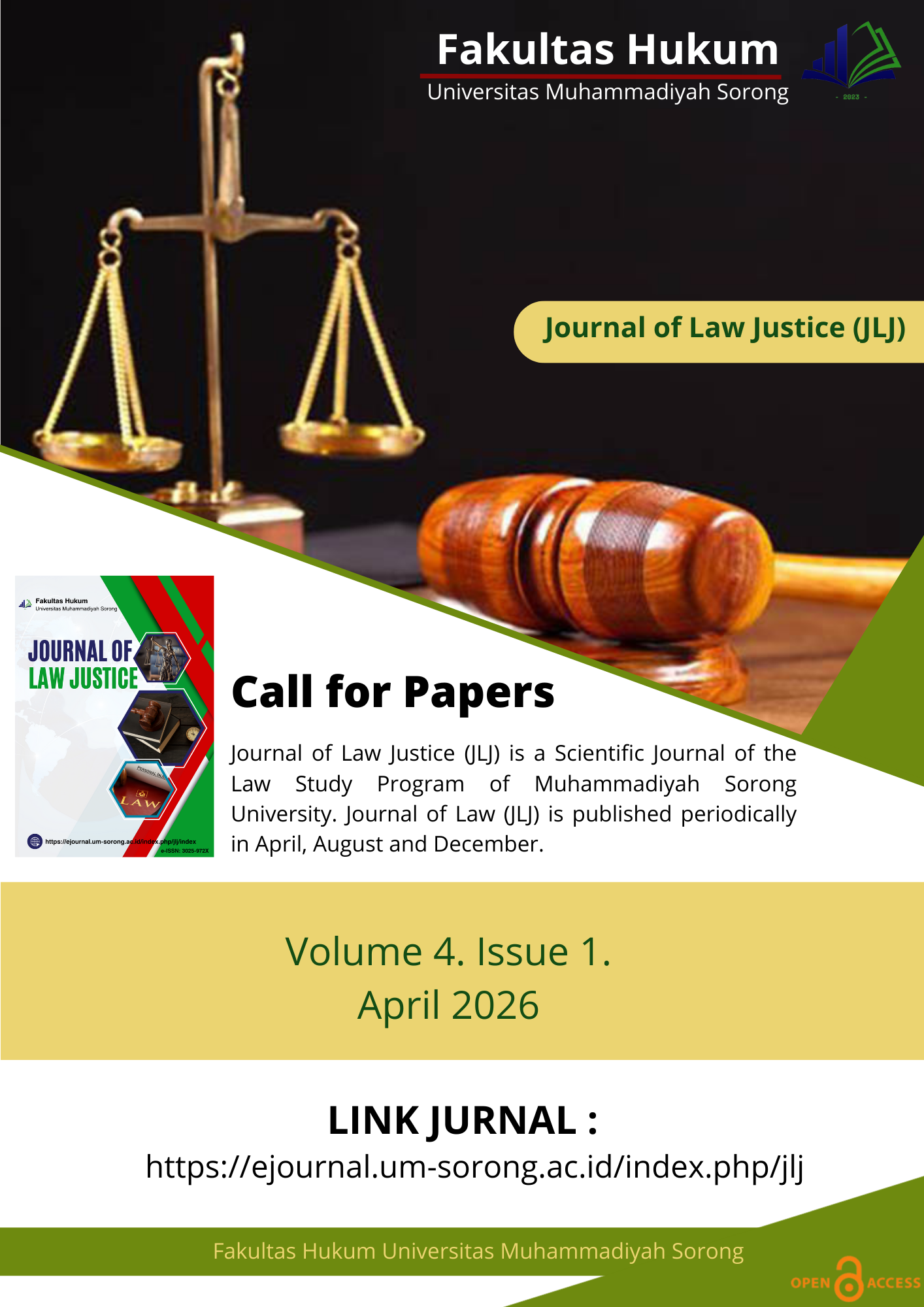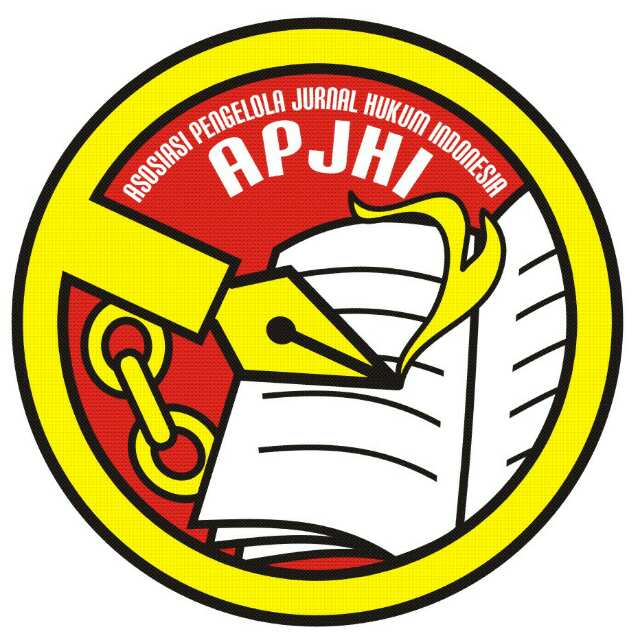The Role of Correctional Institutions in the Development of Prisoners to Prevent Recidivism of Crimes in Sorong City
DOI:
https://doi.org/10.33506/jlj.v2i3.3354Keywords:
Correctional Institutions, Development, PrisonersAbstract
Abstract : Correctional Institution Class II B Sorong is very functional in fostering recidive inmates where in the system of implementing correctional guidance is very necessary participation or participation of the Community, both by cooperating in fostering and being willing to accept back recidive inmates who have completed serving their sentences. This research is an empirical-normative research that prioritizes the results of interviews. The types of data used by the author are primary data and secondary data. The data collection techniques used are literature and field research in the form of interviews. Data analysis used in this research is descriptive-qualitative analysis, namely describing the juridical review of the coaching of recidive prisoners. The coaching of recidive prisoners at the Class II B Sorong Correctional Institution has 3 stages, namely, the initial stage includes the admission stage, orientation and independence coaching stage, from the coaching stage carried out by the Class II B Sorong Correctional Institution is in accordance with Law Number 12 of 1995 concerning Corrections or renewal of Law Number 22 of 2022 concerning Corrections. It's just that the implementation has not been carried out optimally due to several things, among others: lack of correctional officers in the field of religion, lack of health workers, and no surveillance cameras (CCTV), as well as inadequate facilities and infrastructure at the Class II B Sorong Correctional Institution. To the Correctional Institution Class II B Sorong to add Correctional officers and increase cooperation with agencies that can assist in carrying out the guidance of recidive prisoners so that in the future it will be even better.
References
Alawiyah Jufri, Ely, and Nelly Ulfah Anisariza. “Pelaksanaan Asimilasi Narapidana Di Lembaga Pemasyarakatan Terbuka Jakarta.” ADIL: Jurnal Hukum 8, no. 1 (2017): 1–26. https://doi.org/10.33476/ajl.v8i1.452.
Arifai, Arifai. “Pelaksanaan Pembinaan Narapidana Anak Pada Lembaga Pemasyarakatan Di Provinsi Sulawesi Tenggara.” Kalabbirang Law Journal 3, no. 1 (2021): 34–46. https://doi.org/10.35877/454ri.kalabbirang268.
Bachtiar, Moch Agung. “Strategi Pembinaan Kemandirian Terhadap Narapidana Residivis Narkotika ( Studi Kasus Di Lembaga Pemasyarakatan Klas IIA Sidoarjo ).” Jurnal Ilmu Hukum Dan Humaniora 7, no. 1 (2020): 103–15.
Butar-Butar, Frans Sindi, Mhd. Ansori Lubis, and Syawal Amry Siregar. “Penegakan Hukum Tindak Pidana Narkotika Di Kalangan Mahasiswa Yang Diungkap Oleh Direktorat Reserse Narkoba Polda Sumut.” Jurnal Retentum 3, no. 1 (2021). https://doi.org/10.46930/retentum.v3i1.898.
Destiana, Zefa, Muhammad Firdaus, and Anuar Rasyid. “Komunikasi Antarpribadi Petugas Lapas Dalam Pembinaan Narapidana Di Lembaga Pemasyarakatan Perempuan Kelas Ii a Pekanbaru.” Jurnal Ilmu Komunikasi 9, no. 4 (2020): 312–26. https://jkms.ejournal.unri.ac.id/index.php/JKMS/article/download/7391/6481.
Flora, Henny Saida. “Pendekatan Restorative Justice Dalam Penyelesaian Perkara Pidana Dalam Sistem Peradilan Pidana Di Indonesia.” Jurnal Law Pro Justitia II, no. 2 (2017): 41–60.
Azzahra Handhika G. Fajri. “Pelaksanaan Rehabilitasi Narkotika Sebagai Upaya Perawatan Warga Binaan Pemasyarakatan Penyalahgunaan Narkotika Di Lapas Kelas Iia Cibinong.” SOSIOLOGI: Jurnal Ilmiah Kajian Ilmu Sosial Dan Budaya 25, no. 1 (2023): 35–53. https://doi.org/10.23960/sosiologi.v25i1.398.
Harefa, A. “Pembebasan Bersyarat Sebagai Upaya Pembinaan Narapidana Di Lapas Kelas Ii B Gunungsitoli.” JURNAL MathEdu (Mathematic Education Journal) 6, no. 2 (2023): 205–11. https://journal.ipts.ac.id/index.php/MathEdu/article/view/5451%0Ahttps://journal.ipts.ac.id/index.php/MathEdu/article/download/5451/3028.
Hawa, Siti, and Pudji Astuti. “Pidana Penjara Jangka Pendek Terhadap Narapidana Lanjut Usia (Lansia) (Studi Kasus Di Lembaga Pemasyarakatan Kelas IIB Tuban).” Novum: Jurnal Hukum 6, no. 3 (2019): 1–23.
Heliany, Ina, and Edy Santoso. “Kajian Model Pembinaan Narapidana Kasus Narkotika Di Lembaga Pemasyarakatan.” Yure Humano 5 (2021): 1–18.
Hidaya, Wahab Aznul. “Penerapan Diversi Dalam Sistem Peradilan Pidana Anak.” Justisi 5, no. 2 (2019): 84–96. https://doi.org/10.33506/js.v5i2.543.
———. “The Role of Witness and Victim Protection Agency for Imekko Tribe in Criminal Justice System in Sorong” 8, no. 2 (2023): 176–91. https://doi.org/10.23917/laj.v8i2.2363.
Idham, Idham, and Lenny Nadriana. “DISKRIPTIF SISTEM PEMBINAAN NARAPIDANA DI LEMBAGA PEMASYARAKATAN DALAM TINDAK PIDANA NARKOTIKA (Studi Di Lembaga Pemasyarakatan Narkotika Kelas II A Bandar Lampung).” Audi Et AP : Jurnal Penelitian Hukum 1, no. 02 (2022): 108–16. https://doi.org/10.24967/jaeap.v1i02.1672.
Kaidah, Jurnal Hukum. “Media Komunikasi Dan Informasi Hukum Dan Masyarakat.” Jurnal Hukum Kaidah Volume 21, no. Nomor 2 (2022): 137–61.
Kasus, Studi, Penanganan Korupsi, and Pemerintahan Daerah. “Di INDONESIA” 4, no. May (2007): 27–52.
Made Deby Listianitari, Made Sugi Hartono, and Ni Ketut Sari Adnyani. “Pembinaan Narapidana Di Lembaga Pemasyarakatan Kelas Iib Singaraja Bagi Narapidana Yang Dijatuhi Hukuman Pidana Ringan.” Jurnal Komunitas Yustisia 5, no. 2 (2022): 450–63. https://doi.org/10.23887/jatayu.v5i2.51663.
Puspitasari, Citra Anggraeni. “Tanggung Jawab Pemerintah Dalam Pelanggaran Hak Narapidana Dan Tahanan Pada Lembaga Pemasyarakatan/Rumah Tahanan Negara.” Jurnal Panorama Hukum 3, no. 1 (2018): 33–46. https://doi.org/10.21067/jph.v3i1.2342.
Putra, Saifulloh Hamdani. “Pembinaan Kepribadian Dengan Metode Pondok Pesantren Upaya Meningkatkan Pemahaman Agama Islam Bagi Narapidana.” JUSTITIA : Jurnal Ilmu Hukum Dan Humaniora 8, no. 4 (2021): 578–86. http://jurnal.um-tapsel.ac.id/index.php/Justitia/article/download/2677/pdf.
Saputra, Andika Oktavian, Sylvester Enricho Mahardika, and Pujiyono Pujiyono. “Kebijakan Hukum Pidana Dalam Upaya Penanggulangan Tindak Pidana Untuk Mengurangi Overcrowded Lembaga Pemasyarakatan Pada Masa Pandemi Covid-19.” Jurnal Usm Law Review 4, no. 1 (2021): 326. https://doi.org/10.26623/julr.v4i1.3230.
Tarwiyah, Sintia, and Hadi Tuasikal. “Pemenuhan Hak Narapidana Anak Sebagai Upaya Perlindungan Di Lembaga Pemasyarakatan Kelas II B Kota Sorong.” UNES Law Review 6, no. 3 (2024): 9114–29.
Tilolango, Sarbanun, and Andi Ahriani. “Peran Konselor Dalam Membentuk Aktualisasi Diri Narapidana Perempuan Di Lapas Kelas II B Kota Sorong.” PUBLIK: Publikasi Dan Bimbingan Konseling Islam 1, no. 1 (2021): 57–68, 60.
Tobing, PL, and Purbaningrum Purbaningrum. “Efektifitas Program Pembinaan Narapidana Narkotika Di Lembaga Pemasyarakatan Narkotika Kelas IIA Jakarta.” Journal Evidence Of Law 1, no. 1 (2022): 1–20. https://doi.org/10.59066/jel.v1i1.25.
Downloads
Published
How to Cite
Issue
Section
License
Copyright (c) 2024 Rahul Pieter S. Yapen, Wahab Aznul Hidaya, Muharuddin Muharuddin

This work is licensed under a Creative Commons Attribution-ShareAlike 4.0 International License.







